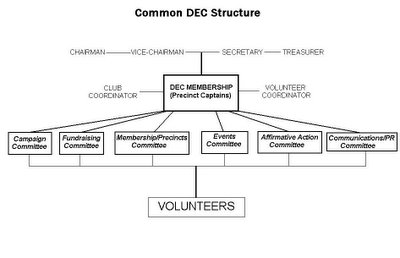 Click on the image for a larger view.
Click on the image for a larger view.As you can see, today's DECs are completely dependent on volunteers and committees. Each of its major responsbilities has a committee dealing with the issue.
In an ideal world, all of this would flow nicely, each committee would have a group of 7-15 members who would world cohesivley to come up with specific solutions and prescriptions to the issues affecting their area of focus. Also, each committee would work with each other and arrange their agendas, operations, and plans accordingly. Designated committee members would make regular reports to the Executive Board (the top 4 elected positions) or a Steering Committee (not mentioned in this DEC model, but is used in some DECs.) The Executive Board or Steering Committee would coordinate and organize all of these committees around a few (3-5) main objectives and guide them in the same direction.
Unfortunately, this isn't an ideal world. As mentioned in my previous post, volunteers aren't terribly reliable, many lack proper training, background, or experience in the necessary fields (communications, events coordination, campaign/project management, fundraising, etc...) and have their own narrow agendas and priorities. These committees usually meet irregularly, if at all in some DECs, and even those that meet regularly usually only meet once a month. This, of course, is not enough to adequately plan and enact operations needed to unseat an entrenched Republican majority, or keeping elected Democrats well supported and reinforced.
We need large structural reforms in DECs if we are to be successful in 2006 and beyond. My next post will be on the ideal DEC structure at different levels (in small, medium, and large counties.)







No comments:
Post a Comment